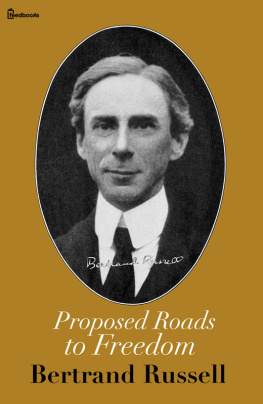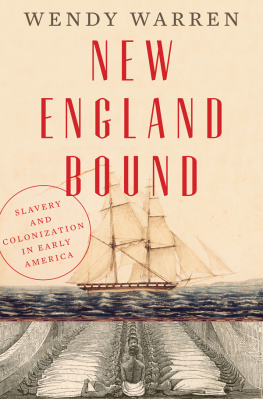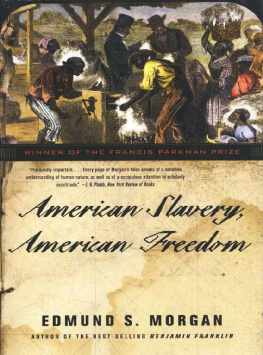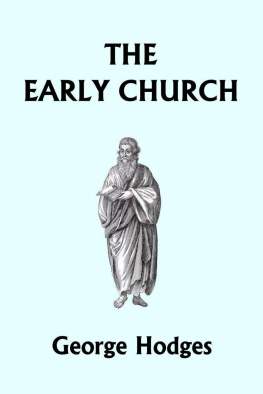SLAVERY, FREEDOM & CULTURE
SLAVERY, FREEDOM & CULTURE
among
EARLY AMERICAN WORKERS
GRAHAM RUSSELL HODGES
First published 1998 by M.E. Sharpe
Published 2015 by Routledge
2 Park Square, Milton Park, Abingdon, Oxon OX14 4RN
711 Third Avenue, New York, NY 10017, USA
Routledge is an imprint of the Taylor & Francis Group, an informa business
Copyright 1998 Taylor & Francis. All rights reserved.
No part of this book may be reprinted or reproduced or utilised in any form or by any electronic, mechanical, or other means, now known or hereafter invented, including photocopying and recording, or in any information storage or retrieval system, without permission in writing from the publishers.
Notices
No responsibility is assumed by the publisher for any injury and/or damage to persons or property as a matter of products liability, negligence or otherwise, or from any use of operation of any methods, products, instructions or ideas contained in the material herein.
Practitioners and researchers must always rely on their own experience and knowledge in evaluating and using any information, methods, compounds, or experiments described herein. In using such information or methods they should be mindful of their own safety and the safety of others, including parties for whom they have a professional responsibility.
Product or corporate names may be trademarks or registered trademarks, and are used only for identification and explanation without intent to infringe.
Library of Congress Cataloging-in-Publication Data
Hodges, Graham Russell, 1946-
Slavery, freedom, and culture among early American workers / Graham Russell Hodges.
p. cm.
Includes bibliographical references and index.
ISBN 0-7656-0112-5 (alk. paper).ISBN 0-7656-0113-3 (pbk. : alk. paper)
1. Afro-AmericansNew York (State)New York RegionHistory18th century. 2. Afro-AmericansNew York (State)New York RegionHistory19th century. 3. Afro-Americans-New York (State)New York RegionSocial conditions. 4. SlaveryNew York (State)New Yoik RegionHistory18th century. 5. SlaveryNew York (State)New York RegionHistory19th century. 6. Working classNew York (State)New York RegionHistory. 7. LaborNew York (State)New York RegionHistory. 8. New York Region-History17751865. I. Title.
F128.9.N3H64 1998
97400496073dc21 9747642
CIP
ISBN 13: 9780765601131 (pbk)
ISBN 13: 9780765601124 (hbk)
Table of Contents
A number of the essays in this book have previously appeared elsewhere and are reprinted by permission. Several were book chapters. The Freemanship in New York City: 16481800, originally appeared in Authority and Resistance in Early New York, Conrad E. Wright and William Pencak, eds. (New York: New-York Historical Society, 1988); Black Revolt in New York and the Neutral Zone, 17751783 was originally printed in New York in the Age of the Constitution, William Pencak and Paul A. Gilje, eds. (Cranbury, NJ: Fairleigh Dickinson University Press, 1992); Desirable Companions and Lovers: African Americans and Irish in New Yorks Sixth Ward, came out in the collection The New York Irish, Ronald Bayor and Timothy Meagher, eds. (Baltimore: Johns Hopkins University Press, 1995). appeared in the Journal of Urban History and are reprinted by permission of Sage Publications.
Over the years many people have assisted me with helpful and sharp criticism of this work. They include Paul A. Gilje, Ronald Bayor, William Pencak, Sylvia Frey, Douglas Egerton, Howard Rock, and Margaret Washington. At Colgate, research for the essays in this book was made possible by grants from the Faculty Research Council. Colgate students who assisted in the research for this volume include Paul Townend and JoEllen Kelleher. Alan Brown was enormously helpful with formatting tables. Trudy King was patient and cheerful as she typed endless drafts. At M.E. Sharpe, Peter Coveney and Eileen Maass were excellent editors who knew how to prod dilatory authors in a firm but friendly fashion. My wife, Margaret Washington, and my parents, Graham and Elsie Hodges, helped in immeasurable ways.
The essays in this book range widely in focus and over time. Beginning with a study of the significance of the freemanship in the earliest years of colonial New York City and ending with a discussion of interracial marriages in antebellum New York Citys Sixth Ward, they touch upon labor, African-American, womens, and urban historiographies. They reflect my own interests and comment upon others excellent scholarship, which I have been fortunate to review at length. Given the scope of these essays, it is difficult to generalize about their meaning, but I hope the reader will find them original and provocative. Individually and collectively, the chapters make some new comments in each of the subfields of early American history mentioned above.
is an appreciation I wrote on the fiftieth anniversary of the publication of Morriss epic. In the essay I emphasize the significance, realized and potential, of Government and Labor to students of labor and racial history. One of the most salient aspects of Morriss huge achievement is what did not get into the final draft. Among the tables and prose cut to curb production costs was material on concerted actions by white and black laborers. As the debates over directions in early black and labor history heat up, the next few essays should offer some insights and raise more questions.
The early history of blacks in America, I contend, turns on the American Revolution. The next three chapters ( includes my thinking on Egertons valuable definitive book on Gabriel.
Three of the final four chapters (, the last chapter in the book, is my own essay on the social politics of interracial marriage in the tumultuous Sixth Ward of antebellum New York City.
SLAVERY, FREEDOM & CULTURE
In 1844 Philip Hone, while rummaging through some old papers, came across the certificate for the freedom of the city awarded to his grandfather eight years before.
The rights and duties of the freemanshipmonopolistic control of labor, suffrage, and public servicewere diffused throughout New York society and formed the basis for an ideological relationship between the classes. In a city considered too great a mixture of nations, the freemanship united everyone who was blessed with citizenship. Even citizens by freehold had to take further steps to obtain the freemanship right and become vested with its powers. In New York City, the freemanship made occupation, as well as ethnicity and wealth, a basis for self-identification.
This essays seeks to restore the central importance of freemanship for understanding the corporate values and ideology of New Yorks early citizenry. Not only did the freemanship remain a live issue during the colonial period, it continued to have fundamental importance as a social and political adhesive well after the Revolution. Freemanship declined in the 1790s only because the ruling Federalists, imposing their political will, chose to deny it to such occupational groups as cartmen, tavern keepers, porters, and grocers. The loss of freemanship contracted the laboring mans political rights and threatened his occupational security. As the nineteenth century opened, the freemanship remained a focal grievance of laborers who sought to have it reinstated to protect their monopolistic position in a rapidly changing economy.










